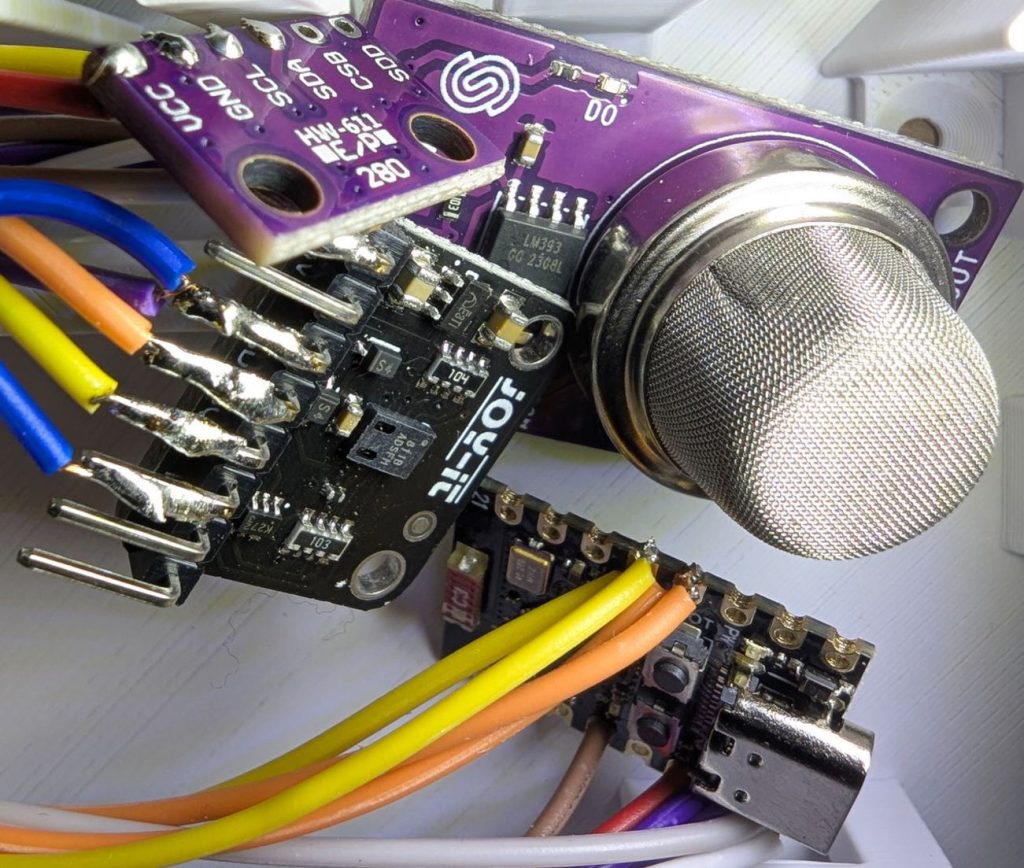Introduction
The ESP32-C3 Supermini offers a compact yet powerful platform for building smart devices. This project demonstrates a smoke detector with environmental monitoring capabilities using the BME280, MQ2, and CSS811 sensors. The device is not designed to replace conventional smoke detectors but aims to provide an early warning system for smoke and poor air quality while also integrating with home automation systems.

How It Works
1. Sensors Overview
- BME280 (Temperature, Humidity, and Pressure):
- Tracks environmental conditions, detecting changes in temperature or humidity that may indicate the early stages of a fire.
- MQ2 (Gas and Smoke Detection):
- Measures the concentration of flammable gases and smoke particles in the air.
- Highly sensitive to smoke from various materials, including wood, paper, and plastics.
- CSS811 (Air Quality Index – CO₂ and VOCs):
- Monitors indoor air quality by detecting levels of carbon dioxide (CO₂) and volatile organic compounds (VOCs), which often increase in fire scenarios.
2. Functional Theory
- Data Collection:
- The BME280 continuously tracks temperature and humidity. A sudden spike in temperature or a drop in humidity can indicate a potential fire.
- The MQ2 detects smoke particles and flammable gases. When the readings exceed a certain threshold, the device triggers an alert.
- The CSS811 measures air quality, providing additional context for detecting abnormal conditions.
- Signal Processing:
- The ESP32-C3 Supermini processes sensor data and uses preset thresholds to evaluate the likelihood of a fire or air quality issue.
- Communication:
- Alerts are sent to a Home Automation system (e.g., Home Assistant) over Wi-Fi. The system logs data, sends notifications, or triggers actions such as activating ventilation systems.
Home Automation Integration
The smoke detector seamlessly integrates into smart home systems to enhance functionality:
- Air Quality Monitoring:
- The device provides real-time air quality data, allowing users to improve indoor air conditions proactively.
- Automation Triggers:
- Set up automations to respond to air quality or smoke alerts. For example:
- Turn on exhaust fans when VOC levels rise.
- Send notifications to mobile devices in case of a potential fire.
- Set up automations to respond to air quality or smoke alerts. For example:
- Early Smoke Detection:
- The device complements traditional smoke detectors by providing low-level alerts when smoke is first detected, offering a critical time advantage.
Current Testing and Limitations
- Fire Detection Testing:
- The fire detection capability is still under evaluation. Accurate thresholds for smoke and gas concentrations are being fine-tuned to minimize false alarms while ensuring reliability.
- Not a Replacement for Conventional Smoke Detectors:
- This device is not intended to replace certified smoke detectors. Its purpose is to provide an additional layer of safety by detecting smoke at lower concentrations before conventional detectors react.
Conclusion
The ESP32-C3 Supermini-based smoke detector is a versatile addition to any smart home. With its ability to monitor air quality and detect smoke early, it offers valuable insights into indoor conditions. While further testing is required for fire detection, this device is an excellent example of how IoT technology can enhance home safety and automation.
By using this system, users can gain an early warning for potential hazards and maintain better control over their home environment. As always, traditional smoke detectors remain essential for reliable fire safety.
